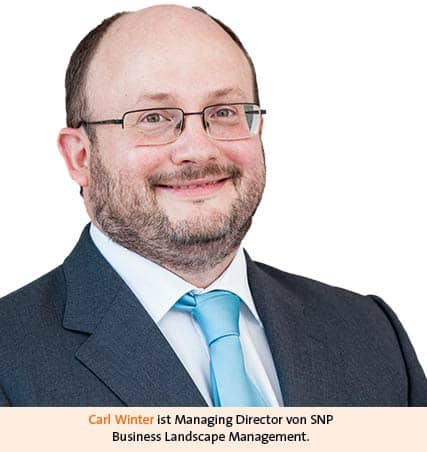Important building block for S/4


The IT departments of these companies are additionally facing a fundamental change, as operating models and IT processes are changing with S/4 Hana.
A successful S/4 Hana go-live therefore requires careful preparation by IT to develop its own roadmap and successfully complete the project.
A central tool for preparing the IT landscape and IT processes is SAP Solution Manager version 7.2.
In many IT departments, Solution Manager is still perceived as an annoying add-on system that is only used to load SAP patches and open system connections to SAP support.
However, the new Release 7.2, which has been available since mid-2016, is so closely linked to S/4 Hana in terms of content and is such an integral part of the roadmaps SAP is providing for the move to S/4 that even customers who have only been using Solution Manager as previously described should re-evaluate SolMan. New central functions, many of them specifically developed or optimized for the move to S/4, are part of the roadmap.
 1. reduce in-house developments and add-ons
1. reduce in-house developments and add-ons
Solution Manager uses Usage Procedure Logging (UPL) to record the usage level of Abap code, programs, procedures, function modules and method.
Ideally, activation takes place 15 months before the conversion to S/4 Hana, but a shorter period is usually sufficient.
Solution Manager Custom Code Lifecycle Management (CCLM) determines which objects are unused, duplicated, not active in any production system, or obsolete, and suggests them for retirement.
This makes it clear which unused program code you can part with. In addition, you can use CCLM to check which functions you have created yourself are now available in the SAP standard and can be replaced by it.
From this, one can deduce which code must be migrated and which ballast can be neglected. This also lays the foundation for later effective custom code lifecycle management.
2. sizing of the future SAP landscape
Data Volume Management (DVM) provides information about data volumes and their distribution in order to identify data reduction potentials.
With a planning lead time of at least six months before the planned S/4 Hana go-live or the purchase of the new hardware, you should analyze the disk requirements.
Subsequently, a decision must be made on what to archive and where to optimize with housekeeping. The goal must be a significant reduction of data.
3. solution documentation and content activation
Those who have already stored process models and solution documentation in SAP Solution Manager 7.1 must prepare and perform the so-called content activation to ensure that the existing documentation can be successfully migrated as part of the upgrade or whether additional conversions are necessary that must be performed in the upgrade.
When upgrading to Solution Manager 7.2, the existing information can only be transferred once. What has not been transferred can only be used in read mode.
With a lead time of six months, one should analyze the existing content and determine which parts of the solution documentation are indispensable and should continue to be used. Projects and reports should also be consolidated here to increase the overview.
Since SAP recommends that only one solution be used with SAP Solution Manager 7.2, customers must be clear in good time about the structure of their future solution documentation.
Once this changeover has been successfully completed, SAP Solution Manager 7.2 with its new, strongly interlinked functions offers the opportunity to always have up-to-date solution documentation available via a link to Change and Release Management. This is also a good starting point for being prepared for audits.
4. reduction of downtime during the technical upgrade to SAP Solution Manager 7.2
The technical migration from version 7.1 to 7.2 is a standard SAP upgrade, but the Abap and Java stack of the underlying SAP NetWeaver system are split (dual stack split).
Customers who are already using the solution documentation must perform the content activation described above. The own upgrade strategy should be measured according to how intensively SAP Solution Manager is already used and how much data is already included.
In the case of extensive use and a lot of transaction data, it is recommended to set up a sandbox in advance in order to test the upgrade steps and, above all, the content activation, to analyze the critical points and to test the throughput time before the productive upgrade.
The technical upgrade in the production system can thus be carried out much faster, and the actual upgrade of SAP Solution Manager can thus also be successfully implemented within a normal weekend.
5. use of the supplied best practices for S/4 project planning.
We recommend that you do not start kicking off S/4 Hana until after the upgrade to version 7.2 or consider the upgrade of the SolMan system as an integral part of the S/4 roadmap.
The operational readiness of the solution is indispensable for implementation, configuration and use. Roadmaps for S/4 Hana new implementations, system conversions and landscape transformations are stored in SAP Solution Manager. These facilitate IT project planning.
S/4 Hana program management for interdependent projects in regions or for different systems is also supported. The SAP Activate methodology - process models and best practices for S/4 Hana implementation provided by SAP - can be used to verify your own planning, while this methodology can be adapted to your own organization.
6. use of the supplied S/4 Hana Business Content
The S/4 Hana standard processes are described in SAP Solution Manager. The Business Content already provided - SAP recommendations for implementing business processes with S/4 Hana - should be very valuable for many companies.
It is a good idea to check the possible uses of SAP best practices for your own business processes and, if necessary, to trace them back to the SAP standard.
If modifications are made, the SAP Solution Manager functions should be used for requirements, test and release management.
This increases the transparency, overview and operational reliability of the ERP systems, especially if the adaptation of the documentation becomes an integral part of the change management and the adaptation of functions is always accompanied by the adaptation of the corresponding documentation.
7. adaptation of IT processes
In the previous version 7.1 of SolMan, the functions for IT service management were also expanded to conform to ITIL. However, the end-to-end use of these highly integrated processes has been implemented in very few companies. Often, the possibilities offered by SAP Solution Manager are only partially known.
Version 7.2 once again offers many functional enhancements that can help IT departments work more efficiently and economically with the business. In the future, many users in SAP Solution Manager will not come from the IT department, but from business areas.
If the use of Solution Manager increases as described, it will also become a central system for the entire company and it must be available in a similar way to the ERP system, because a failure would have serious consequences.
Such organizational effects must be recognized early on, carefully analyzed and already changed with the S/4 Hana project or the SAP Solution Manager sub-project.
SAP Solution Manager offers IT organizations a wide range of monitoring options. For example, the availability of the SAP infrastructure, the Hana database and the on-premise, cloud and hybrid components can be permanently checked.
Mission-critical business processes can also be monitored so that malfunctions can be quickly detected, causes analyzed and malfunctions corrected.
8. end-to-end change, test and release management for the S/4 rollout
IT decision-makers know how important the interaction of these processes is in the SAP context. With SAP Solution Manager, SAP user companies get an ITIL-certified tool integrated into SAP to control all related processes.
With its innovations, it simplifies the flow of information between business departments and the IT organization on IT and business requirements, change requests, their testing and the associated rollout.
If business processes are documented and change requirements are traceable, test cases can be written more precisely and software quality increases.
In addition, the onboarding of new employees is simplified, the need for training is reduced, and increasing compliance requirements are also taken into account.
9. optimized IT processes for the business unit
As part of the digital transformation, new user groups are coming into contact with IT in general and with SAP in particular.
IT organizations should strive to lay the foundation for digitization via positive experiences with the service desk in particular, but also with the other IT processes.
With standard interfaces from previous SAP Solution Manager versions, this was only possible to a limited extent. With SAP Fiori and the direct integration of IT processes into business processes, this is now much more possible with Release 7.2.
Conclusion
S/4 Hana will decisively change processes and how people work together in companies in many places. Long-term planning is an important prerequisite for successfully mastering these changes.
The adjustment of the IT strategy must take place as the first important step for the S/4 conversion. For IT organizations, Solution Manager is likely to become an indispensable tool and control instrument for SAP projects and SAP operations in this context.





